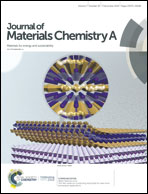Carbon nanofibers@NiSe core/sheath nanostructures as efficient electrocatalysts for integrating highly selective methanol conversion and less-energy intensive hydrogen production†
Abstract
H2 generation from water electrolysis is a key enabling technology for a clean and sustainable future but is still restricted by the sluggish oxygen evolution reaction (OER). So exploring an ideal electrocatalytic valorization reaction to replace the sluggish OER and boost H2 production is desirable. Methanol, as the most important liquid C1 resource with huge production capacity, is rather inexpensive and practical for utilization. In this work, in situ synthesized carbon nanofibers@NiSe (CNFs@NiSe) core/sheath nanostructures act as robust and stable electrocatalysts for highly selective methanol conversion to value-added formate with a high production rate and faradaic efficiency. Notably, the methanol conversion replaces the sluggish OER to boost H2 production at a high generation rate that is 7.5 times that in the absence of methanol, thus lowering the energy consumption. Density functional theory (DFT) calculations reveal that the high electrocatalytic selectivity is attributed to the unique exposed NiSe (102) facets, which facilitate the methanol conversion to formate by suppressing further oxidation to the greenhouse gas CO2.



 Please wait while we load your content...
Please wait while we load your content...